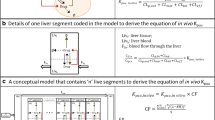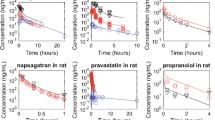Abstract
Purpose
To examine the theoretical/practical utility of the liver-to-blood partition coefficient (Kpuu) for predicting drug-drug interactions (DDIs), and compare the Kpuu-approach to the extended clearance concept AUCR-approach.
Methods
The Kpuu relationship was derived from first principles. Theoretical simulations investigated the impact of changes in a single hepatic-disposition process on unbound systemic (AUCB,u) and hepatic exposure (AUCH,u) versus Kpuu. Practical aspects regarding Kpuu utilization were examined by predicting the magnitude of DDI between ketoconazole and midazolam employing published ketoconazole Kpuu values.
Results
The Kpuu hepatic-disposition relationship is based on the well-stirred model. Simulations emphasize that changes in influx/efflux intrinsic clearances result in Kpuu changes, however AUCH,u remains unchanged. Although incorporation of Kpuu is believed to improve DDI-predictions, utilizing published ketoconazole Kpuu values resulted in prediction errors for a midazolam DDI.
Conclusions
There is limited benefit in using Kpuu for DDI-predictions as the AUCR-based approach can reasonably predict DDIs without measurement of intracellular drug concentrations, a difficult task hindered by experimental variability. Further, Kpuu changes can mislead as they may not correlate with changes in AUCB,u or AUCH,u. The well-stirred model basis of Kpuu when applied to hepatic-disposition implies that nuances of intracellular drug distribution are not considered by the Kpuu model.



Similar content being viewed by others
Abbreviations
- A H :
-
Amount of drug in the liver
- AUC R :
-
Area under the concentration time curves expressed as the ratio of interaction to control
- AUC B,u :
-
Area under the concentration time curve of unbound drug in the blood following an oral dose
- AUC H,u :
-
Area under the concentration time curve of unbound drug in the liver following an oral dose
- C B :
-
Total concentration of drug in the blood
- C B,u :
-
Unbound drug concentration in blood
- C H :
-
Total concentration of drug in the liver
- C H,bil :
-
Total concentration of drug in the liver driving biliary excretion
- C H,eff :
-
Total concentration of drug in the liver driving basolateral efflux
- C H,met :
-
Total concentration of drug in the liver driving metabolism
- CL H,int :
-
Hepatic intrinsic clearance (sum of metabolic intrinsic clearance and intrinsic biliary secretion)
- CL H,int,bil :
-
Hepatic intrinsic biliary secretion
- CL H,int,met :
-
Hepatic intrinsic metabolic clearance
- C H,u :
-
Unbound drug concentration in the liver
- CYP:
-
Cytochrome P450
- DDI:
-
Drug-drug interaction
- F abs :
-
Fraction absorbed
- F G :
-
Fraction escaping intestinal elimination
- f u,B :
-
Fraction of unbound drug in blood
- f u,H :
-
Fraction of unbound drug in liver
- f u,inc :
-
Fraction of unbound drug in an in vitro incubation
- f u,plasma :
-
Fraction of unbound drug in plasma
- I max,u :
-
Maximal unbound plasma concentration of inhibitor drug
- K i :
-
Unbound inhibition constant of inhibitor drug
- Kp uu :
-
Unbound liver-to-blood partition coefficient
- PBPK:
-
Physiologically-based pharmacokinetic
- PD:
-
Pharmacodynamics
- PS eff,int :
-
Basolateral efflux (both active and passive) intrinsic clearance
- PS inf,int :
-
Basolateral influx (both active and passive) intrinsic clearance
References
Chu X, Korzekwa K, Elsby R, Fenner K, Galetin A, Lai Y, et al. Intracellular drug concentrations and transporters: measurement, modeling, and implications for the liver. Clin Pharmacol Ther. 2013;94(1):126–41.
Trainor GL. The importance of plasma protein binding in drug discovery. Expert Opin Drug Discovery. 2007;2(1):51–64.
Camenisch G, Riede J, Kunze A, Huwyler J, Poller B, Umehara K. The extended clearance model and its use for the interpretation of hepatobiliary elimination data. ADMET & DMPK. 2015;3(1):1–14.
Benet LZ, Bowman CM, Liu S, Sodhi JK. The extended clearance concept following oral and intravenous dosing; theory and critical analysis. Pharm Res. 2018;35(12):242.
Benet LZ, Bowman CM, Sodhi JK. How transporters have changed basic pharmacokinetic understanding. AAPS J. 2019;21(6):103.
Barton HA, Lai Y, Goosen TC, Jones HM, El-Kattan AF, Gossed JR, et al. Model-based approaches to predict drug-drug interactions associated with hepatic uptake transporters: preclinical, clinical and beyond. Expert Opin Drug Metab Toxicol. 2013;9(4):459–72.
Camenisch G, Umehara K. Predicting human hepatic clearance from in vitro drug metabolism and transport data: a scientific and pharmaceutical perspective for assessing drug-drug interactions. Biopharm Drug Dispos. 2012;33(4):179–94.
El-Kattan AF, Varma MVS. Navigating transporter sciences in pharmacokinetics characterization using the extended clearance classification system. Drug Metab Dispos. 2018;46(5):729–39.
Patilea-Vrana G, Unadkat JD. Transport vs. metabolism: what determines the pharmacokinetics and pharmacodynamics of drugs? Insights from the extended clearance model. Clin Pharmacol Ther. 2016;100(5):413–8.
Sirianni GL, Pang KS. Organ clearance concepts: new perspectives on old principles. J Pharmacokinet Biopharm. 1997;25(4):449–70.
Varma MV, Steyn SJ, Allerton C, El-Kattan AF. Predicting clearance mechanism in drug discovery: extended clearance classification system (ECCS). Pharm Res. 2015;32(12):3785–802.
Webborn PJH, Parker AJ, Denton RL, Riley RJ. In vitro-in vivo extrapolation of hepatic clearance involving active uptake: theoretical and experimental aspects. Xenobiotica. 2007;37(10–11):1090–109.
Tsunoda SM, Velez RL, von Moltke LL, Greenblatt DJ. Differentiation of intestinal and hepatic cytochrome P450 3A activity with use of midazolam as an in vivo probe: effect of ketoconazole. Clin Pharmacol Ther. 1999;66(5):461–71.
U.S. Food and Drug Administration, Center for Drug Evaluation and Research. In vitro metabolism- and transporter-mediated drug-drug interaction studies: guidance for industry. Silver Spring, MD; 2017.
Greenblatt DJ, Venkatakrishnan K, Harmatz JS, Parent SJ, von Moltke LL. Sources of variability in ketoconazole inhibition of human cytochrome P450 3A in vitro. Xenobiotica. 2010;40(10):713–20.
Martínez-Jordá R, Rodriguez-Sasiain JM, Suárez E, Calvo R. Serum binding of ketoconazole in health and disease. Int J Clin Pharmacol Res. 1989;10(5):271–6.
Iwasaki S, Kosugi Y, Zhu AZX, Nakagawa S, Sano N, Funami M, et al. Application of unbound liver-to-plasma concentration ratio to quantitative projection of cytochrome P450-mediated drug-drug interactions using physiologically based pharmacokinetic modelling approach. Xenobiotica. 2019;49(11):1251–9.
Riede J, Camenisch G, Huwyler J, Poller B. Current in vitro methods to determine hepatic Kpuu: a comparison of their usefulness and limitations. J Pharm Sci. 2017;106(9):2805–14.
Li Z, Di L, Maurer TS. Theoretical considerations for direct translation of unbound liver-to-plasma partition coefficient from in vitro to in vivo. AAPS J. 2019;21(3):43.
Nordell P, Winiwarter S, Hilgendorf C. Resolving the distribution-metabolism interplay of eight OATP substrates in the standard clearance assay with suspended human cryopreserved hepatocytes. Mol Pharm. 2013;10(12):4443–51.
Riede J, Poller B, Huwyler J, Camenisch G. Assessing the risk of drug-induced cholestasis using unbound intrahepatic concentrations. Drug Metab Dispos. 2017;45(5):523–31.
Benet LZ, Hoener B-a. Changes in plasma protein binding have little clinical relevance. Clin Pharmacol Ther. 2002;71(3):115–21.
Benet LZ, Bowman CM, Koleske ML, Rinaldi CL, Sodhi JK. Understanding drug-drug interaction and pharmacogenomic changes in pharmacokinetics for metabolized drugs. J Pharmacokinet Pharmacodyn. 2019;46(2):155–63.
Varma MV, Bi YA, Kimoto E, Lin J. Quantitative prediction of transporter- and enzyme-mediated clinical drug-drug interactions of organic anion-transporting polypeptide 1B1 substrates using a mechanistic net-effect model. J Pharmacol Exp Ther. 2014;351(1):214–23.
Loryan I, Sinha V, Mackie C, Van Peer A, Drinkenburg W, Vermeulen A, et al. Mechanistic understanding of brain drug disposition to optimize the selection of potential neurotherapetuics in drug discovery. Pharm Res. 2014;31(8):2203–19.
Ufuk A, Assmus F, Francis L, Plumb J, Damian V, Gertz M, et al. In vitro and in silico tools to assess extent of cellular uptake and lysosomal sequestration of respiratory drugs in human alveolar macrophages. Mol Pharm. 2017;14(4):1033–46.
Tsmandouras N, Dickinson G, Guo Y, Hall S, Rostami-Hodjegan A, Galetin A, et al. Development and application of a mechanistic pharmacokinetic model for simvastatin and its active metabolite simvastatin acid using an integrated population PBPK approach. Pharm Res. 2015;32(6):1864–83.
Riccardi KA, Tess DA, Lin J, Patel R, Ryu S, Atkinson K, et al. A novel unified approach to predict human hepatic clearance for both enzyme- and transporter-mediated mechanisms using suspended human hepatocytes. Drug Metab Dispos. 2019;47(5):484–92.
Bowman CM, Benet LZ. An examination of protein binding and protein-facilitated uptake relating to in vitro-in vivo extrapolation. Eur J Pharm Sci. 2018;123:502–14.
Gertz M, Cartwright CM, Hobbs MJ, Kenworthy KE, Rowland M, Houston JB, et al. Cyclosporine inhibition of hepatic and intestinal CYP3A4, uptake and efflux transporters: application of PBPK modeling in the assessment of drug-drug interaction potential. Pharm Res. 2013;30(3):761–80.
Rowland Yeo K, Walsky RL, Jamei M, Rostami-Hodjegan A, Tucker GT. Prediction of time-dependent CYP3A4 drug-drug interactions by physiologically based pharmacokinetic modelling: impact of inactivation parameters and enzyme turnover. Eur J Pharm Sci. 2011;43(3):160–73.
Mateus A, Matsson P, Artursson P. Rapid measurement of intracellular unbound drug concentrations. Mol Pharm. 2013;10(6):2467–78.
Acknowledgements and DISCLOUSURES
This work was supported in part by a Mary Ann Koda-Kimble Seed Award for Innovation. Ms. Sodhi was supported in part by an American Foundation for Pharmaceutical Education Predoctoral Fellowship, NIGMS grant R25 GM56847 and a Louis Zeh Fellowship. Dr. Benet is a member of the UCSF Liver Center supported by NIH grant P30 DK026743. All authors contributed to the writing, derivations, simulations and analysis of this manuscript. The authors declare no conflict of interest.
Author information
Authors and Affiliations
Corresponding author
Additional information
Publisher’s Note
Springer Nature remains neutral with regard to jurisdictional claims in published maps and institutional affiliations.
Rights and permissions
About this article
Cite this article
Sodhi, J.K., Liu, S. & Benet, L.Z. Challenging the Relevance of Unbound Tissue-to-Blood Partition Coefficient (Kpuu) on Prediction of Drug-Drug Interactions. Pharm Res 37, 73 (2020). https://doi.org/10.1007/s11095-020-02797-w
Received:
Accepted:
Published:
DOI: https://doi.org/10.1007/s11095-020-02797-w




